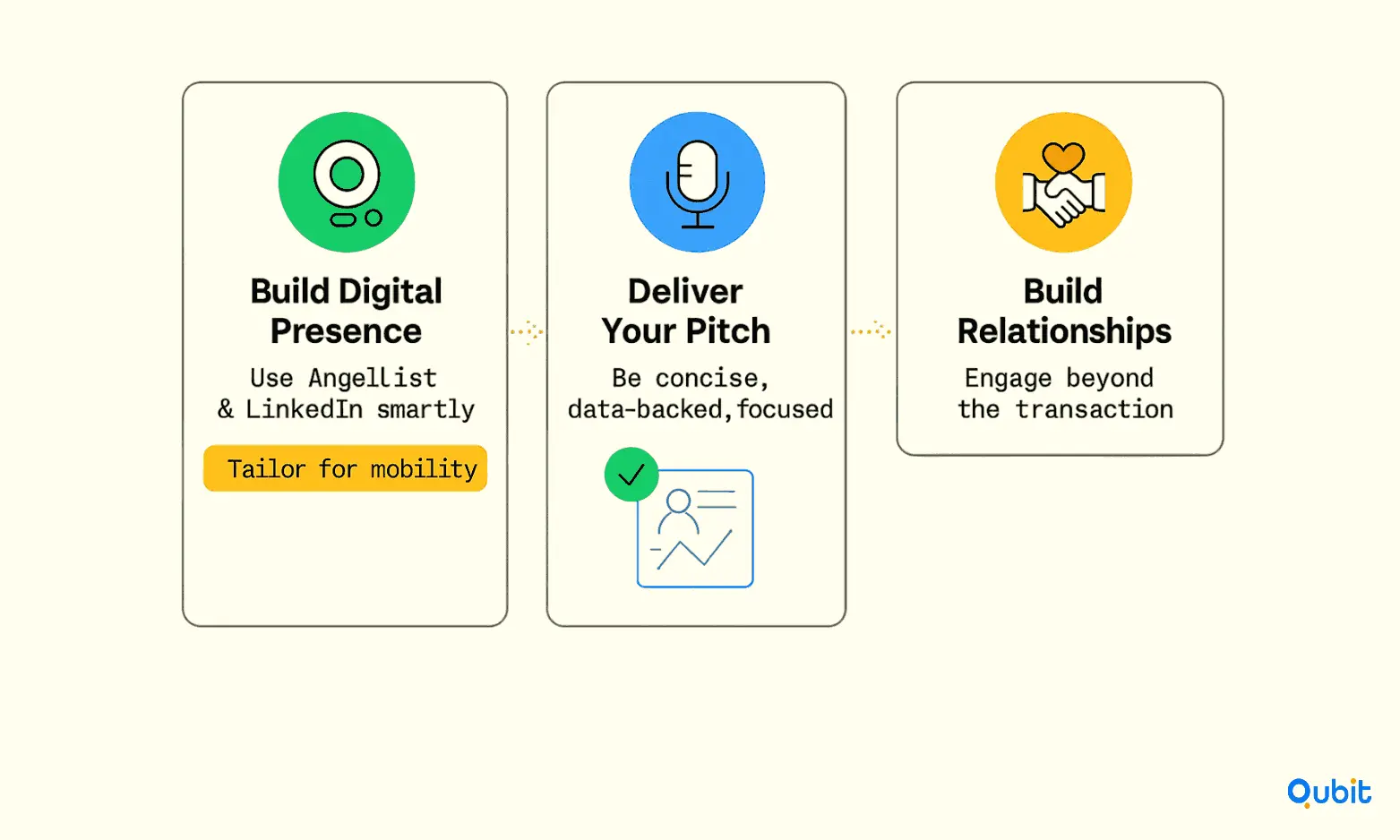Selecting the right investor is a pivotal decision for any startup, shaping not only its financial trajectory but also its strategic direction. The process extends beyond securing capital; it’s about identifying partners who align with your vision, values, and long-term goals. The alignment ensures that both parties can collaboratively navigate challenges and seize opportunities.
This blog will explore the critical factors to consider when choosing an investor, including strategic fit, favorable terms, and the importance of long-term alignment. Let’s dive in!
Choosing the Right Investor: Selection & Attraction
Recent trends underline mobility sector growth. In 2024, global mobility investment spiked $10 billion in new capital, pushing totals to $54 billion. This surge highlights investors' active interest, rewarding founders who demonstrate scalability and sector alignment. For startups, tracking these patterns positions teams to attract the most relevant investors.
Choosing the right investor is as critical as crafting a winning business strategy. The process of choosing the right investor involves aligning your startup’s goals with an investor’s vision. Founders should prioritize investors with relevant industry knowledge, strong track records, values aligned to the startup, and clear financial transparency. These criteria ensure strategic fit and partnership longevity.
This section explores the essential criteria for investor selection. It also provides actionable steps to attract the right funding opportunities.
Criteria for Selecting the Right Investor
Identifying the ideal investor requires a clear understanding of your business needs and the investor’s expertise. Here are the key factors to consider:
- Market Understanding: Investors with a deep knowledge of your industry can offer more than just capital. Their insights and connections can accelerate growth.
- Scalable Business Model: building a scalable model (a business design that can grow revenue without a matching rise in costs)
- Demonstrated traction (proven demand and user or revenue growth): According to statistics, 42% of investors consider demonstrated traction, such as customer acquisition and revenue growth, as the key factor in their decision-making process. Highlighting your traction can significantly improve your chances of securing funding.
- Clear Vision: A well-defined roadmap for your business ensures that investors see the potential for sustainable growth.
- Experienced Team: A strong team with proven expertise instills confidence in investors about your ability to execute the business plan.
- Financial Transparency: Transparent financial records build trust and demonstrate your commitment to accountability.
Why Team Diversity and Expertise Matter
These criteria also require founders to build teams with diverse backgrounds and deep sector expertise. Investors often view such teams as more resilient and capable of navigating complex mobility challenges. Diversity fosters innovation and broadens the startup’s perspective, which is especially valued in dynamic markets. Highlighting your team’s unique strengths can significantly increase investor confidence and interest.
Best Practices for Investor Pitches
a. Showcase Your Traction
Investors prioritize startups that have already demonstrated market validation. For instance, Jugnoo, a local mobility solution, scaled rapidly by leveraging its traction and aligning with the right investors. Highlighting your growth metrics, such as user acquisition rates or revenue milestones, can make your pitch more compelling.
b. Develop a Scalable Strategy
A scalable business model is non-negotiable for most investors. Ensure your pitch emphasizes how your product or service can expand to meet growing demand without proportionally increasing costs.
c. Build Relationships with Specialized Investors
Engaging with investors who specialize in your niche can significantly enhance your chances of success. For example, insights from pitch EV investors mobility startups illustrate the dynamics specific to engaging with investors centered on electric vehicle innovations. This information enriches your understanding of how specialized investor networks integrate with broader funding strategies.
d. Communicate a Clear Vision
Your pitch should articulate not only your current achievements but also your long-term vision. Investors want to see how their capital will contribute to scaling your business and achieving sustainable growth.
e. Highlight Your Team’s Expertise
A capable and experienced team is often the backbone of a successful startup. Showcase the skills and accomplishments of your core team members to build investor confidence.
f. Maintain Financial Transparency
Investors value transparency. Ensure your financial records are accurate, up-to-date, and accessible. This demonstrates professionalism and builds trust.
Using Non-Dilutive Funding for Investor Readiness
Building on these steps, founders should strategically pursue non-dilutive funding such as grants or subsidies before equity rounds. This approach extends operational runway without sacrificing ownership, making the startup more attractive to investors. Demonstrating resourcefulness through non-dilutive capital signals strong financial discipline and reduces pressure to accept unfavorable investment terms. Integrating these funding sources can also support critical milestones, strengthening your position during negotiations.
By focusing on these criteria and steps, you can effectively attract investors who align with your business goals, paving the way for a successful partnership. For instance, understanding the nuances of mobility VC risk appetite can shed light on how investor priorities evolve in response to market trends.
Investor Outreach Strategies
Connecting with potential mobility investors is a crucial step in choosing the right investor for your startup. This requires a thoughtful approach that combines clear communication, strategic use of digital platforms, and a focus on building lasting relationships.

1. Build a Strong Digital Presence
Digital platforms like AngelList and LinkedIn are invaluable tools for reaching investors. On AngelList, creating a profile that highlights your unique value proposition is essential. Include a step-by-step guide to showcase your startup’s strengths, such as its innovative solutions or market potential. Similarly, optimizing your LinkedIn profile can help attract specialized mobility investors. Ensure your profile is complete, professional, and tailored to emphasize your expertise and vision for the mobility sector.
Digital presence matters right now. EV startup funding rose 27% in 2025, demonstrating more investor deal activity where visibility is strong. Founders who optimize profiles on platforms like AngelList and LinkedIn can directly benefit from this heightened interest and take part in new capital flows.
2. Deliver a Clear and Compelling Pitch
Investors are drawn to clarity and confidence. Your pitch should succinctly outline your startup’s mission, the problem it solves, and the market opportunity. Use data and real-world examples to back your claims, and tailor your pitch to the interests of each investor.
3. Foster Relationships Beyond the Pitch
Investment decisions often hinge on trust and rapport. Engage with potential investors through meaningful conversations, industry events, or even informal meetings. Demonstrating genuine interest in their expertise and aligning your goals with their investment philosophy can make a lasting impression.
For startups exploring alternative outreach methods, an exploration of mobility startup crowdfunding syndicate mechanisms highlights complementary financing avenues that resonate with innovative mobility ideas.
By combining these strategies, you can position your mobility startup as a compelling opportunity for investors.
Startup Opportunity & Business Building
Establishing a strong foundation is essential for any startup aiming to thrive in the competitive mobility market. Before approaching investors, startups must focus on refining their core business strategies and ensuring long-term sustainability. A well-structured plan not only attracts potential investors but also positions the business for consistent growth.
One of the first steps involves identifying and addressing gaps in your operational framework. This includes optimizing processes, building a scalable model (a business design that can grow revenue without a matching rise in costs), and ensuring that your product or service aligns with market demands. Understanding local markets can also improve your fundraising strategy.
For instance, the examination of mobility tech startup funding India sheds light on regional funding trends within the transportation and logistics tech sectors. This contextual detail supports your evaluation of localized investment opportunities as part of a broader fundraising strategy.
Aligning with Sustainability and Regulatory Trends
This foundation enables startups to align their business models with current sustainability and regulatory trends. Incorporating environmental goals and compliance measures demonstrates long-term viability to investors focused on impact. Proactively addressing these areas can open doors to specialized funds and partnerships. It also positions your startup to adapt as industry standards and expectations evolve.
Strategic planning creates long-term upside. Industry forecasts show the global auto tech market could surpass $400 billion by 2030. Startups focused on scale and demand positioning stand to benefit from this significant expansion, which reinforces the case for establishing strong operating foundations now.
Post-Investment Relationship Management
Securing investment is just the start. Choosing the right investor makes relationship management post-close crucial for long-term value and founder peace of mind.
- Regular updates matter. Monthly or quarterly reports, focused on KPIs, wins, and asks, keep investors engaged and informed. Use real data: customer wins, fleet uptime, burn (monthly cash outflow) and cash position, regulatory milestones.
- Utilize the network. Actively ask for introductions, advice, and share key hiring or partnership needs. Investors often help most when prompted.
- Address problems early. Bring challenges (supply issues, regulatory delays, cash flow crunches) to the table early, investors prefer “bad news fast” and are often able to help.
- Plan for boardroom dynamics. Set agendas well in advance, provide relevant docs early, and foster a culture of problem-solving, not blame-shifting.
The Power of Strategic Fit: A Mobility Success Story
When Berlin-based EV startup Motio secured investment from a climate-tech VC with deep municipal connections, their Series A was just the beginning. Beyond capital, the investor unlocked pilots with three European cities and introduced the startup’s founders to supply partners that cut manufacturing costs by 15%.
By contrast, a peer that prioritized the highest term sheet from a purely financial investor struggled to gain local traction and burned through its runway pivoting between unvetted markets.
Example: An early-stage mobility SaaS team found better traction with a seed-fund VC focused on software, rather than hardware-focused investors.
Sector-wide, active investors drive such outcomes. EIT Urban Mobility manages a portfolio of over 140 mobility startups, demonstrating substantial practical commitment to innovation. Founders supported by this network often access pilots, large partnerships, and operational cost advantages far beyond capital alone.
- Lesson: Founders who optimize for network, not just dollars, achieve better long-term outcomes.
Planning for Exit and Liquidity: Investor Fit and Endgame
The right investor should align with your growth journey and your exit vision.
- Discuss exit preferences early. Some VCs optimize for M&A, others for IPOs, while corporates may prefer long-term commercial alignment.
- Negotiate secondary sales (private resales of shares before company exit). As cycles lengthen, ask how your investors facilitate employee or founder liquidity (e.g., in growth rounds or pre-exit secondaries).
- Review alignment on strategic buyer scenarios. Do key investors have ties or conflicts with likely acquirers? Will they support, or block, specific exit paths?
- Protect founder and early employee upside. Ensure vesting, cap table (capitalization table) clarity, and waterfall calculations are clean in every scenario.
Pitfall: Some investors may block potential acquisitions or insist on extended timelines conflicting with founders’ goals.
Conclusion
Choosing the right investor is more than just securing funding; it's about building a partnership that aligns with your vision and values.
Throughout this blog, we’ve explored strategies to identify investors who share your long-term goals, emphasized the importance of crafting a compelling narrative, and outlined actionable steps to ensure alignment. By focusing on these principles, you can create a foundation for sustainable growth and mutual success.
If you're ready to take the next step, our Investor Discovery and Mapping service offers tailored insights to connect you with the most suitable partners. Let us help you find the perfect match for your startup’s journey. Let’s get started.
Key Takeaways
- Comprehensive guide on selecting the right investor for mobility startups.
- Detailed investor profiles and actionable outreach strategies provide clear benchmarks.
- Emphasis on traction, market understanding, and sustainable growth is critical.
- Step-by-step insights help align investor selection with long-term business objectives.
Frequently asked Questions
What should I look for in an investor for my mobility startup?
Look for investors with industry experience and a proven track record. They should understand mobility market challenges and value your long-term vision. Strategic fit, relevant network, and supportive guidance are essential for your mobility startup.






